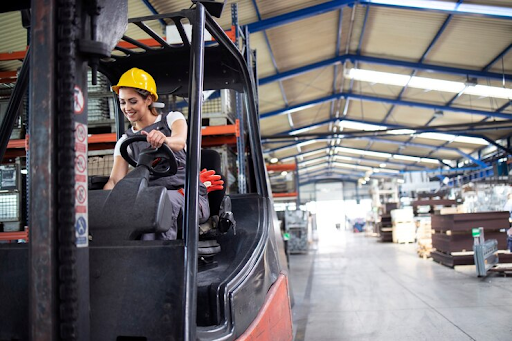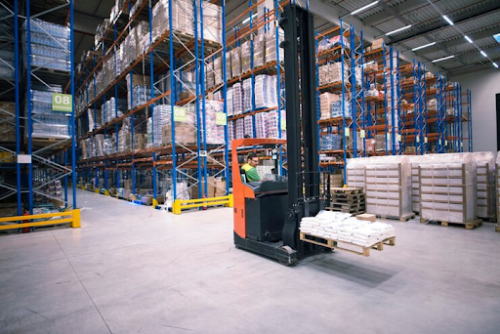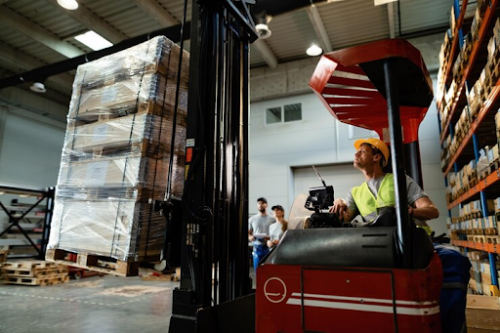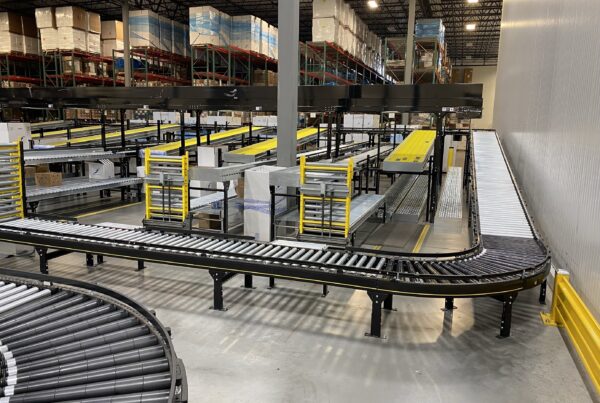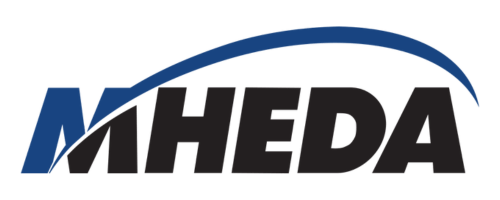As inflation rises, the expenses associated with renting or owning a warehouse are leading to small facility sizes. To meet increased demands, companies are seeking more efficient, space-maximizing solutions. This shift has replaced the traditional warehouse aisles with narrowed ones. Today, narrow and very narrow aisle designs are typically 50-60% smaller, offering additional space to store goods and perform other essential activities.
However, narrow aisles require specialized vehicles to move efficiently, as traveling and operating this close to rackings can damage stored goods or infrastructure. Operators must move in balance where they can conveniently pick items and maintain enough distance to travel without hitting racks. To address this challenge, companies now use narrow aisle-reach forklifts designed for tight spaces, like VNA or order pickers, instead of conventional sit-down forklifts.
For optimal performance in narrow aisles, many facilities use a rail or wire guidance system for forklifts. These systems free operators from steering and allow them to focus on order picking, resulting in high productivity and lower damage.
Both rail and wire guidance systems have similar benefits but differ in installation and operation. When it comes to wire guidance vs. rail guidance, choosing the right navigation system is integral for a safer, more efficient warehouse.
Rail Guidance Systems in a Brief
As the name suggests, rail guidance systems have physical rails fixed on both sides of the aisle or at the width of the forklift. They guide the forklift along a fixed route, ensuring it stays centered in the aisle.
As the forklift moves, it touches the rails on each side and travels safely. This helps reduce the risk of damaging the drive-in pallet racks or the order picker. The system includes guide rollers and rails within the aisles, specifically for Very Narrow Aisle (VNA) forklifts.
Physical rails are installed in the ground and front of the racking to set the path. Advanced systems, like auto-center steering, include a guide roller with a sensor. Once the sensor gets triggered, it automatically centers the forklift, allowing it to continue moving straight down the aisle.
Each warehouse setup is different, so proper configuration of the rails and guide rollers is required. This ensures operators can work safely and efficiently while minimizing obstacles. Depending on the aisle width and available space, the rails might need to be built directly into the racking system.
Wire Guidance Systems at a Glance
Wire guidance or line drive is a system designed for VNA forklifts. It uses an electromagnetic guidewire buried underneath the floors to help forklifts steer through the narrow warehouse aisles safely and smoothly. The wires are usually epoxy-coated for damage protection.
Wire guided forklift trucks (order pickers and turret trucks) have sensors that detect the guidewire and follow its path, allowing the vehicle to move vertically along the aisles. The wire guidance can be extended beyond the end of the rack up to 15 feet and in the case of order pickers, it is 10 feet.
Wire guidance is an elaborate setup. It is ideal for medium and high-level VNA trucks. It comes with various configurable features, such as slowing down when the truck reaches the end-of-aisle and customizable travel speed.
Operators can even deactivate the guidance when needed, enabling forklifts to travel outside the wire’s confines. This is a beneficial feature in scenarios where wires could restrict the forklift movement when it tries to reach products outside the outlined path or aisle.
When active, wire guidance again takes over the steering and enables operators to focus on travel and lift tasks, improving efficiency and productivity. Like rail guidance, wire guidance can be used in any aisle type but is most commonly found in narrow and very narrow aisle applications.
Wire Guidance vs. Rail Guidance: Detailed Comparison
Both wire guidance and rail guidance systems play a key role in improving productivity and safety in narrow and very narrow aisle (VNA) warehouses. However, they differ on various parameters that we shall compare here:
1) Installation
Many entities are associated with wire guidance systems including embedding wires in the floor to create an electromagnetic path that guides forklifts. Such a placement requires sensors and specialized equipment in the forklift wire guidance and the facility’s infrastructure, making the process more intricate.
In contrast, rail guidance relies on physical rails installed along the aisle edges to guide the forklift’s wheels. This installation is generally more straightforward but offers less adaptability than wire guidance.
2) Flexibility
Wire guidance allows operators to deactivate the system when necessary, allowing forklifts to travel outside the confines of the wire. This flexibility is helpful for operations that require varied movements. On the other hand, rail guidance restricts forklifts to the rails, limiting movement but ensuring precise, consistent travel within the designated aisles.
3) Applications
Wire guidance is versatile and can be used in all aisle types, although it is most commonly found in very narrow aisle applications. It enhances productivity by enabling operators to focus solely on travel and lift tasks. Rail guidance, on the other hand, is best suited for fixed-aisle configurations where forklifts operate in the same lanes repeatedly. This system is ideal for straightforward and repetitive workflows.
4) Maintenance
Wire guidance systems require regular checks of the embedded wires, sensors, and electrical systems to maintain proper functionality. Fixing them can be more complex because of advanced technological usage which draws higher repair costs. Rail guidance, in contrast, requires simpler maintenance, such as occasional alignment checks and repairs for physical rail wear, making it a more cost-effective option in the long run.
5) Price
Wire guidance tends to be more expensive because of the costs associated with the sensors, forklift modifications, and the installation of wires and electrical components. Rail guidance, however, is a more budget-friendly option, with lower upfront costs due to its simpler technology and installation requirements.
Which Guidance System to Choose?
Before zeroing in on either of the systems, you must weigh these key factors:
1) Pricing
Cost is one of the considerations that can impact your decision. As with wire and rail guidance systems, pricing varies significantly. Wire guidance is often more expensive because of the sensors, equipment, and electrical installations done on both forklifts and within the facility. Again, the size of your fleet and warehouse will decide the total cost.
2) Site and Application
Rail guidance might be a better option in warehouses with wider aisles where operators need to move between racks on both sides for order picking. It has a simpler physical structure than wire guidance systems.
3) Load Requirements
What size, weight, and type of products your business deals with and needs picking for can also impact your choice. For heavy products in narrow aisles, wire guidance is often a better choice, as this offers better control and maneuverability in tight spaces. This system helps maintain a safe distance between the vehicle and the aisles, thus reducing the chance of operator injuries and forklift damage.
4) Warehouse Layout and Scalability
When deciding between the two systems, consider aisle width, storage configuration, and future growth plans. If you are a scaling business, an embedded wire guidance system might be a more appropriate choice for you than manual rails. These systems are more scalable and adaptable.
Deciding Between Wire and Rail Guidance for Efficient Forklift Navigation
Whether you choose wire or rail guidance, the decision should be based on your specific operational requirements.
Wire guidance offers flexibility, scalability, and precision but it is more on the expensive side. Rail guidance is a simpler, more affordable solution for fixed, repetitive tasks.
Both systems can increase productivity and reduce product and rack damage. However, they are not suitable for all situations. It is important to consult with a professional to ensure that the system you choose is right for your specific needs.
At SRSI, we specialize in delivering custom warehouse automation solutions that boost efficiency and improve performance. With innovative and custom strategies and solutions, we are here to optimize your operations for success.
Frequently Asked Questions
1) How can I calculate forklift aisle width?
You can calculate the minimum aisle width using the formula: Minimum Aisle Width = Right angle stack + Load length + 12 inches. The extra 12 inches ensure the forklift can drive easily in the aisle without difficulty.
2) Can wire and rail guidance systems be used together?
Most warehouses use either wire or rail guidance. However, in rare cases, a combination of both can be implemented. Hybrid systems are employed for specific operational needs.
3) Which system is more suitable for high-density storage?
Wire guidance is more appropriate for high-density storage because it provides precise movement control. It also supports automation, making it efficient in tight storage areas.
4) What is the cost of installing wire guidance systems?
The installation costs can vary greatly on several factors, including the size of your warehouse and the complexity of the system. It’s best to get a custom estimate.
5) Can an existing warehouse be retrofitted with wire guidance?
Yes, a warehouse can be retrofitted, but it involves significant changes to the flooring and layout. This process may require some downtime to complete the adjustments.
 Skip to main content
Skip to main content
